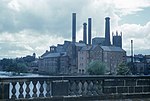Ye Olde Dolphin Inne
East Midlands building and structure stubsGrade II listed buildings in DerbyGrade II listed pubs in DerbyshireNational Inventory PubsPub stubs ... and 3 more
Timber framed buildings in EnglandUnited Kingdom listed building stubsUse British English from August 2014

Ye Olde Dolphin Inne is a Grade II listed pub, on Queen Street, in the city of Derby, England.It is on the Campaign for Real Ale's National Inventory of Historic Pub Interiors.It was built in the late 16th century, with the licence said to date from 1580, and is the oldest pub in Derby. The timber-framed exterior of the building was remodeled in the early 20th century. The pub appears on the 1620 map of John Speed.The 18th-century extension, on the left-hand side of the building in Full Street, was originally a doctor's house, wherein he dissected the bodies of criminals who had been hanged.
Excerpt from the Wikipedia article Ye Olde Dolphin Inne (License: CC BY-SA 3.0, Authors, Images).Ye Olde Dolphin Inne
Queen Street, Derby Little Chester
Geographical coordinates (GPS) Address Website Nearby Places Show on map
Geographical coordinates (GPS)
| Latitude | Longitude |
|---|---|
| N 52.925124 ° | E -1.477796 ° |
Address
Oviso
Queen Street 4
DE1 3DL Derby, Little Chester
England, United Kingdom
Open on Google Maps







